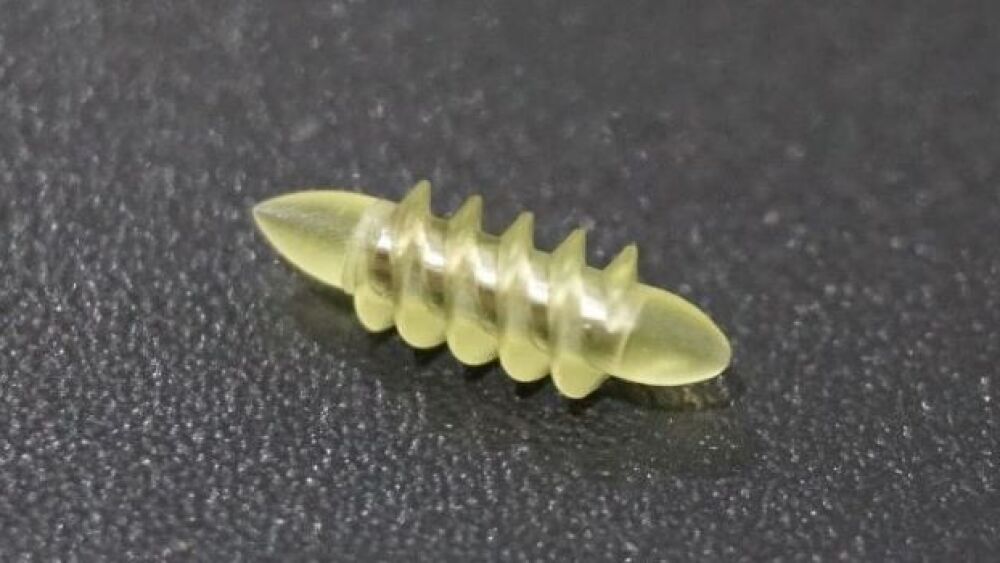Bionauts™, a novel treatment modality that uses remote-controlled microscale robots to deliver biologics, nucleic acids, or small molecule therapies to precise areas of the brain, has the potential to go where no therapy has gone before, opening up new pathways in the fight against devastating CNS disorders like gliomas and Huntington’s disease.
Close-up of a Bionaut™/Photo courtesy of Jon McKee Photography
Diseases of the brain are often considered the holy grail of the therapeutic landscape – and Bionaut Labs, who today emerged from stealth mode in a $20 million Series A, is sending its Bionauts™ off in search of it.
Bionauts™, a novel treatment modality that uses remote-controlled microscale robots to deliver biologics, nucleic acids, or small molecule therapies to precise areas of the brain, have the potential to boldly go where no therapy has gone before, opening up new pathways in the fight against devastating CNS disorders like brainstem glioma and Huntington’s disease.
“There was this film called Fantastic Voyage that actually has a submarine going into the brain and treating an aneurysm I think. What used to be science fiction now is really science reality, because, over the last few decades, science has allowed us to effectively manufacture micro-scale objects, and scale rapid prototyping capabilities,” said Bionaut Labs’ co-founder and chief executive officer, Michael Shpigelmacher.
Khosla Ventures, which led this round of financing, clearly agreed.
“We are thrilled to bring Bionaut Labs out of stealth mode as it typifies the type of new impactful technology companies we like to help build,” said Khosla founder, Vinod Khosla. “Bionauts™ hold great promise as a new targeted treatment modality for severe brain disorders for which there are few, if any, effective treatment options. Moreover, the broad therapeutic potential of Bionauts™ extends to many diseases where conventional therapies are limited or lacking.”
Joining Khosla in the syndicate were Upfront Ventures, Revolution, BOLD Capital and Compound.
A significant part of the Bionauts™’ potential lies in augmenting the efficacy of gene therapies, CRISPR, anti-sense oligonucleotides (ASOs), and oncolytic viruses.
“We bring into the picture the anatomical precision, getting into the right anatomical target, and then once we release the payload, it provides the cellular, or biochemical precision, in the right spot. And that is oftentimes the gap, that anatomical precision,” Shpigelmacher said.
Bionaut’s inaugural pursuit is glioma – a deadly malignant tumor found within the glial tissue of the nervous system that continues to confound scientists and surgeons alike. Shpigelmacher explained how the right systemic delivery mechanism could revolutionize the CNS treatment space.
“All of the brain conditions, largely all of the CNS conditions, suffer from the fact that the brain and CNS is uniquely designed to protect itself from the external world, and that means that the blood-brain barrier prevents effective systemic treatment. Which means that if one can build a gateway to the CNS, you can treat many conditions potentially with one tool. That’s what we’re aiming to do,” he said.
Thus far, in animal studies, Bionaut has successfully treated orthotopic glioma tumors in mice, eliminating toxicity with guided delivery of therapeutic payloads directly into the tumor. The company plans to conduct Good Laboratory Practice (GLP) studies in 2022, with the hope of reaching the clinic in 2023.
Once Bionaut has established the modality in glioma, it plans to embark on riskier therapeutic pursuits, such as Huntington’s disease.
“For Huntington’s…there are promising payloads, but they’re not at the point where they are clinically approved or well-characterized,” Shpigelmacher said. “Our going hypothesis is that instead of treating the entire CSF [Cerebrospinal fluid] volume around the whole brain and spine, or instead of doing an invasive procedure, we could deliver those payloads in a targeted fashion toward a specific location around the basal ganglia.”
Shpigelmacher predicted that micro-robots have the potential to change the way therapeutics are developed.
“Most drugs fail the FDA approval because of dosage problems because they can’t get the efficacy on target to be good enough while not being toxic off-target,” he said. “If you have a technology like Bionaut™ that allows you to engineer the therapeutic index to release a payload only where you need it, not in other places, then you can actually reduce the cost of your drug R&D and duration of your clinical trials because you don’t spend as much effort and resources on dosage optimization.”






